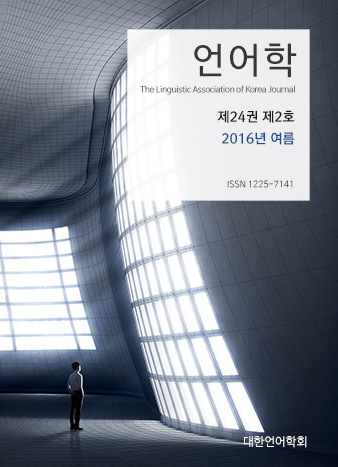대한언어학회 전자저널

-
A Corpus-based Study on the Use of English Present Perfect by Chinese EFL Learners
-
A Study of Curricular Components of English/Korean-Language Textbooks
-
The Effects of Listening Encoding Strategy Use on Korean EFL Learners’ EAP Listening Comprehension
-
A Study on the Correlation between Self-Efficacy Beliefs and Strategies in English Reading
24권 2호 (2016년 6월)
Abstract
Keywords
# Causatives # Anticausatives # Derivational/Non-derivational Approach # Applicative
References
- Alexiadou, A. (2010). On the morphosyntax of (anti-)causative verbs. In R. Hovav E. Doron & I. Sichel (ed). Syntax, Lexical Semantics & Event Structure, (pp. 177-203). Oxford Press.
- Alexiadou, A. & E. Doron. (2012). The syntactic construction of two non-active Voices: Passive and middle. J. Linguistics 84, 1-34.
- Bae, H-I. (1988). A Study of Korean Passive. Research Institute of Korean Studies, Korea Univ. Seoul.
- Kim, J.M. (2014). A Typological Study of Anticausatives, Middle and Medio-Passive Constructions. Studies in Modern Grammar 81, 65-89.
- Kim, K-M. (2009). Two Types of Inchoatives in Korean. Language Research 45.2, 231-255.
- Kim, K-M. (2011). High applicatives in Korean causatives and passives. Lingua 121, 487-510.
- Kalluli, D. (2007). Rethinking the Passive/Anticausative Distinction. Linguistic Inquiry 38(4), 770-780.
- Keyser, S. and T. Roeper. 1984. On the middle and ergative constructions in English. Linguistic Inquiry 15, 381-416(405).
- Levin, B. (1993). English Verb Classes and Alternation. The University of Chicago Press: Chicago and London.
- Levin, B. and Rappaport Hovav M. (1995). Unaccusativity: at the syntax-lexical semantic interface. Linguistic Inquiry Monograph 26. Cambridge, Mass.; MIT Press.
- Lim, D. S. (2015). hankuke pocotongsa ‘-(e)cita’ey kwanhan soko ‘A study of the Korean auxiliary ‘-ecita’. Korean Jourmnal of Linguistics, 40-4, (pp. 661-673).
- Nam, S. K. (2011). ‘-ecida’uymi kochal-ey tayhan silon ‘A study of the meaning of -ecita’. emunyenku 39(3), 175-202.
- Pylkkänen, L. (2008). Introducing Arguments. Cambridge: MIT Press.
- Rappatport Hovav, M. (2014). Lexical content and context: The causative alternation in English revisited. Lingua 141, 8-29.
- Rappaport Hovav, M. and B. Levin. (2011). Lexicon uniformity and the causative alternation. In Everaert, M., Doron, E., Schel, I. (ed). The Theta System: Argument Structure at the Interface, (pp.21-38). Oxford Univ. Press: Oxford.
- Schäfer, F. (2008). The syntax of (anti)-causatives: External arguments in change-of-state contexts. Amsterdam: John Benjamins.